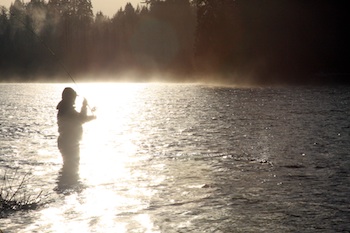 I haven’t been this excited about winter steelheading for a long time. Maybe that’s because I have some new gear to try out, ranging from Patagonia’s bomber River Salt Jacket to Thomas & Thomas’ DNA 12-foot 8-weight spey rod. Much of my excitement comes from having cast a spey rod quite a bit in 2012 and the fact that I now feel pretty competent with those big sticks. I’m eager to hit Vancouver Island or maybe even Haida Gwaii, along with some coastal streams in Oregon, early in 2013.
I haven’t been this excited about winter steelheading for a long time. Maybe that’s because I have some new gear to try out, ranging from Patagonia’s bomber River Salt Jacket to Thomas & Thomas’ DNA 12-foot 8-weight spey rod. Much of my excitement comes from having cast a spey rod quite a bit in 2012 and the fact that I now feel pretty competent with those big sticks. I’m eager to hit Vancouver Island or maybe even Haida Gwaii, along with some coastal streams in Oregon, early in 2013.
With that said, I recall how winter steelheading often feels like an impossible mission. So I thought I might offer a few basics that I keep in mind when I’m on the water and conditions aren’t so favorable. This helps me keep the faith and casting mostly well when I don’t even know if there are any fish in the river, let alone grabby ones. Hopefully these notes will help you keep the faith, too.
Go low and Slow Winter steelhead fin in cold water. They don’t want to move fast or far for a fly. You’ll want you patterns to tick the bottom rocks occasionally and you want to mend line to keep those patterns moving slowly across a run. Got to give those fish a chance to eat and that definitely means going low and slow.
Fish the Tailouts If there’s one water type I’d concentrate on for winter steelhead, especially if I were just getting into the sport, it would be the tailouts of runs and pools. Sometimes steelhead will hang right at the lip of a pool, just a few feet above the start of a rapid. Other times they’ll move 10 or 15 yards up from the lip, but will still be holding in relatively shallow water where it’s easy to put a fly in front of their faces. Tailouts are especially good in the mornings when the fish are not harassed and they are feeling good because the light isn’t strong. Cast methodically and work those tails and you will, eventually, find your fish.
Pick ‘yer Pocket Some people switch flies for winter steelhead like crazy. Others stick with a single fly all day long. I fall between those mentalities—I have patterns that I believe in and I carry them in various colors and I switch colors through the day, depending on light conditions and how I feel at that moment. Sometimes I just say, I think they’ll eat pink right now. Other times it’s black or blue. I really do think it’s more about putting a fly in front of a steelhead that wants to eat, rather than choosing the right color or style of fly. Fly selection gets easier after you land your first few steelhead because you have a fly that’s worked before that you can go back to with confidence. The one commercial fly I’ll fish before just about any other? The Pick ‘yer Pocket. Try it, brothers, you’ll like it.
T-14 This is magnum sinking line and you’ll want to carry 10-foot, 12-foot and maybe even 15-foot sections of the stuff. You can vary the sink rates of each by the way you mend. A big belly in you line and head keeps the fly up; a modest belly or no belly allows the fly to sink. You aren’t going to reach bottom and swing it successfully with a floating line or T-8. You have to get this bottom bouncing tip and go down to where the fish are. And that means you’ll want to throw a spey rod, which give you more distance with your cast and allows you to manage line much better than you could with a single-hander.
Fish A Falling RiverRarely do winter steelheaders fish in prime conditions, but if you watch the weather you can fish when a river is falling rather than rising, which is typically considered the best time to fish, although we all know that the best time to fish is when you can. That said, steelhead are most grabby when a river has risen with rain and begins to fall. Typically, you’ll get the prime, prime about two or three days after the peak, depending on how high the river rose in the first place. Keep an eye on the weather and USGS river gauge information and you’ll get your best shots at success.


6 Responses to Five Tips for Pacific Northwest Winter Steelhead